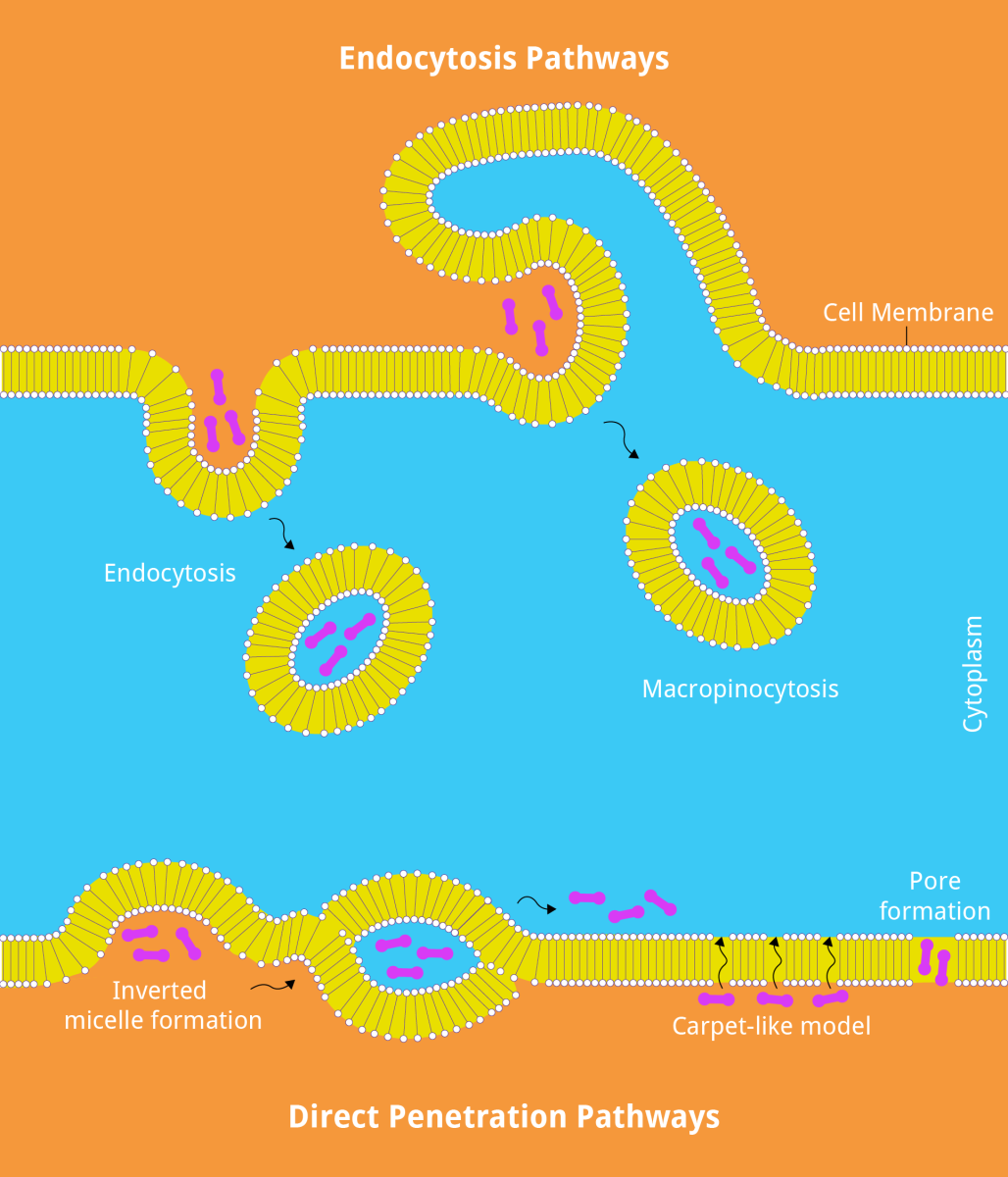You have no items in your shopping cart.
Cell Penetrating Peptides
Cell penetrating peptides (CPPs) are a class of small peptides between 4-40 amino acids that can cross the cell membrane. Not only can they pass through themselves, but they can also transport attached molecules such as nucleic acids, proteins, drugs, and imaging agents. It is their ability to transport their cargo into cells that has made them a focus for study in the treatment of disease.
CPPs were first discovered in the late 1980s. TAT was the first CPP discovered and is one of the most commonly studied in the literature today. This peptide is derived from the transcriptional activator protein of HIV and is used to transport macromolecules into cells. Below is a list of TAT peptides, TAT conjugated peptides, and their areas of impact.
CPP | Sequence | Activity |
|---|---|---|
H-Gly-Arg-Lys-Lys-Arg-Arg-Gln-Arg-Arg-Arg-Pro-Pro-Gln-OH | Transports molecules into cells | |
H-Tyr-Gly-Arg-Lys-Lys-Arg-Arg-Gln-Arg-Arg-Arg-Gln-Thr-Leu-Gln-Ala-Glu-Leu-Leu-Val-Val-Tyr-Gly-Ala-OH | Dll4-Notch1 inhibitor; Anti-tumor properties | |
H-Tyr-Gly-Arg-Lys-Lys-Arg-Arg-Gln-Arg-Arg-Arg-Gly-Gly-Thr-Asn-Val-Phe-Asn-Ala-Thr-Phe-Glu-Ile-Trp-His-Asp-Gly-Glu-Phe-Gly-Thr-OH | Autophagy inducing peptide; Prevents replication of HIV-1 and West Nile virus | |
H-Tyr-Gly-Arg-Lys-Lys-Arg-Arg-Gln-Arg-Arg-Arg-Lys-Gln-Ile-Glu-Ile-Lys-Lys-Phe-Lys-OH | Connexin43 hemichannel inhibitor; Anti-inflammation properties | |
H-Tyr-Gly-Arg-Lys-Lys-Arg-Arg-Gln-Arg-Arg-Arg-Arg-Leu-Pro-Gly-Lys-Glu-Thr-Met-Ala-OH | GluR6-PSD95 interaction blocker; Neuroprotective properties | |
H-Tyr-Gly-Arg-Lys-Lys-Arg-Arg-Gln-Arg-Arg-Arg-Arg-Thr-Lys-Ser-Gly-Val-Tyr-Leu-Val-Gly-Arg-Arg-Arg-Gly-OH | α-Synuclein knockdown peptide; Neuroprotective effects | |
H-Tyr-Gly-Arg-Lys-Lys-Arg-Arg-Gln-Arg-Arg-Arg-Arg-Ser-Phe-Pro-His-Leu-Arg-Arg-Val-Phe-NH2 | Blocks the interaction of ANXA1 with importin β; Neuroprotective effects | |
H-Tyr-Gly-Arg-Lys-Lys-Arg-Arg-Gln-Arg-Arg-Arg-Ser-Pro-Met-Gly-Val-Asp-His-Met-Ser-Gly-Leu-Ser-Gly-Val-Asn-Val-Pro-Gly-Asn-Ala-Ser-Ser-Gly-OH | HuR-PARP1 interaction blocker; Anti-inflammatory effects |
CPPs are diverse, and no standardized classification system has been developed. Most commonly, CPPs are classified by their origin (naturally-derived, chimeric, synthetic) or chemical properties (cationic, amphipathic, hydrophobic). The mechanisms by which CPPs cross the cell membrane are still being studied, as they are influenced by numerous factors. Depending on their chemical structure, cargo, and concentration, CPPs can pass through the cell membrane via direct translocation or endocytosis. Translocation methods of entry require no energy input and include pore formation, membrane thinning, and inverted micelle formation. On the contrary, endocytosis is an energy-requiring process in which CPPs are transported into cells via vesicles/vacuoles and released into the plasma membrane via endosomal escape.

Diagram showing endocytosis and direct penetration pathways.
Because of their ability to cross the cell membrane with their cargo, research efforts have focused on their potential drug-delivery and diagnostic applications. With regards to drug-delivery, research efforts have focused on treatments for cancer, neurodegenerative diseases, and genetic disorders. Efforts are also studying the pairing of antiviral peptide drugs with CPPs to treat viral infections such as HIV, HBV, and HPV. Below is a list of CPPs and their areas of impact.
CPP | Sequence | Activity |
|---|---|---|
H-Arg-Gln-Ile-Lys-Ile-Trp-Phe-Gln-Asn-Arg-Arg-Met-Lys-Trp-Lys-Lys-OH | CPP that helps bring cargo into cells; Alternative to TAT | |
H-Arg-Arg-Arg-Arg-Arg-Arg-Arg-Arg-Arg-OH | Has antifungal and neuroprotective properties | |
H-Gly-Arg-Lys-Lys-Arg-Arg-Gln-Arg-Arg-Arg-Cys-Met-Glu-Leu-Lys-Thr-Glu-Glu-Glu-Glu-Val-Gly-Gly-Val-Gln-Pro-Val-Ser-Ile-Gln-Ala-OH | Blocks ASIC1a binding to RIPK1; Neuroprotective properties | |
H-Tyr-Ala-Arg-Ala-Ala-Ala-Arg-Gln-Ala-Arg-Ala-Lys-Ala-Leu-Ala-Arg-Gln-Leu-Gly-Val-Ala-Ala-OH | MAPK-activated protein kinase II inhibitor; Studied for potential impacts in neuroinflammation, cancer, and IBD | |
H-Arg-Gln-Ile-Lys-Ile-Trp-Phe-Gln-Asn-Arg-Arg-Met-Lys-Trp-Lys-Lys-Arg-Tyr-Cys-Ser-Gly-Lys-Ser-Lys-Lys-Pro-Val-NH2 | Cx26 interaction region mimetic; Anti-tumor properties | |
H-Tyr-Gly-Arg-Lys-Lys-Arg-Arg-Gln-Arg-Arg-Arg-Glu-Tyr-Val-Gln-Thr-Val-Lys-Ser-Ser-Lys-Gly-OH | ANXA1–EphA2 interaction blocker; Anti-cancer properties | |
Ac-Gly-Arg-Lys-Lys-Arg-Arg-Gln-Arg-Arg-Arg-Pro-Pro-Gln-Ser-Lys-Arg-Lys-Lys-Asn-Lys-Lys-Gly-Lys-Arg-Lys-NH2 | Downregulates EPS8 expression; Anti-cancer properties | |
H-Phe-Leu-Gly-Val-Leu-Ala-Leu-Leu-Gly-(D)Tyr-Leu-Ala-Val-Arg-Pro-(D)Phe-Leu-Pro-Lys-(D)Lys-Lys-Gln-Gln-Lys-OH | Anti-cancer properties | |
Stearyl-Asp-Leu-Ile-Glu-Glu-Ala-Ala-Ser-Arg-Ile-Val-Asp-Ala-Val-Ile-Glu-Gln-Val-Lys-Ala-Ala-Gly-Ala-Tyr-OH | AKAP-PKA interaction inhibitor; Functions in metabolic cell health |
Pre-clinical studies have yielded promising results; however, further research is needed before treatments receive approval. One further area of study is peptide stability, as peptides can undergo numerous changes including oxidation, deamidation, and disulfide exchange within the body. These changes can destabilize the peptide, resulting in their degradation and ineffectiveness. If CPPs degrade before reaching the target cell/tissue, there is a concern for cell toxicity as absorption by other cells/tissues can be harmful. Research efforts continue to progress in this area due to the tremendous potential offered by CPPs.
References
- Gori A, Lodigiani G, Colombarolli SG, Bergamaschi G, Vitali A, ChemMedChem 2023, 18, e202300236.
- Khairkhah N, Namvar A, Bolhassani A. Application of Cell Penetrating Peptides as a Promising Drug Carrier to Combat Viral Infections. Mol Biotechnol. 2023 Sep;65(9):1387-1402. doi: 10.1007/s12033-023-00679-1. Epub 2023 Jan 31. PMID: 36719639; PMCID: PMC9888354.
- Reveret, L., Leclerc, M., Morin, F. et al. Pharmacokinetics, biodistribution and toxicology of novel cell-penetrating peptides. Sci Rep 13, 11081 (2023). https://doi.org/10.1038/s41598-023-37280-0
- Sebbage V, Cell-penetrating peptides and their therapeutic applications, Bioscience Horizons: The International Journal of Student Research, Volume 2, Issue 1, March 2009, Pages 64–72, https://doi.org/10.1093/biohorizons/hzp001

